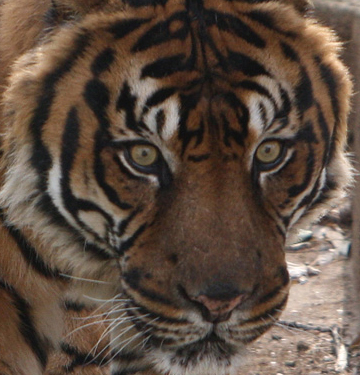A female Sumatran tiger (Panthera tigris sumatrae) has been relocated from her threatened rainforest home to Sembilang National Park. According to Asia Pulp and Paper (APP) and the Sumatran Tiger Conservation Foundation (YPHS), the tiger had become an issue in its home region due to human and wildlife conflict. The group touted saving the tiger as ‘a significant moment for Sumatran tiger preservation’. However, Greenpeace says that the tiger would never have been a problem if APP were not destroying its habitat.
“If APP cared about tigers, it would stop destroying the rainforests that are critical to their long-term survival. Instead, through PR sleight of hand the company is now trying to hide the causes of today’s relocation exercise and pretend that this is a success story for tiger conservation,”’ Zulfhami of Greenpeace South East Asia said in a press release.
The tiger in question has been named ‘Purti’, which in Indonesian means princess, but at 7-years-old it was anything but dainty. As their habitat is lost and they are pushed closer-and-closer to human habitations, Sumatran tigers have attacked and killed several loggers and plantation workers.
 Sumatran tiger in captivity. Photo by: Rhett A. Butler. |
“We are so proud to be part of a team of such dedicated and committed experts who share a common goal, to help ensure the safety of Putri as well as people living and working in the forests of South Sumatra. We are working together to find ways for people and tigers to live harmoniously,” said Aida Greenbury, APP Managing Director in a press release.
At the time of her capture, Purti was living in PT Sumber Hijau Permai plantation forest. In fact, according to Greenpeace two people were killed in the plantation by tigers during the past year. Its likely these killings—which have been kept largely under wraps—spurred the the relocation of the tigeress.
“The process of safely rescuing a tiger that has come into contact with humans, caring for it while we find a suitable location for a new home and then orchestrating a safe release is extremely delicate. It requires careful planning and involvement of so many groups working together and working on behalf of the tiger,” said Bastoni, YPHS’ senior conservationist. The Sumatran Tiger Conservation Fund (YPHS) was initiated and continues to be supported by APP, but has no support from tiger conservationists or scientists.
This tiger relocation is only the latest in tiger issues for APP. Last week, it was revealed that a tiger had been caught in a snare trap in an APP concession. After days of starvation and dehydration, the tiger perished just after being rescued. Not far from where the tiger died, an APP subsidiary was documented clearing forest. Initial reports stated that the tiger was accidentally killed by a hunting snare meant for other animals, but Fauna and Flora International (FFI)-Indonesia told mongabay.com that they believe the snare was set purposefully for a tiger, which could be viewed as a pest or alternatively as a valuable commodity for the traditional Chinese medicine market. The group added that while the use of snares is illegal in Indonesia, there are no penalties against use.
The Sumatran tiger subspecies is listed as Critically Endangered by the IUCN since poaching, decrease in prey, and widespread logging for palm oil and paper products has brought the tiger down to about 500 survivors in the wild. Already, Indonesia has lost two tiger subspecies: the Bali tiger went extinct in the 1930s and the Javan tiger in the 1970s.
Zulfhami, with Greenpeace, says that what is not often reported is that forest destruction in Indonesia impacts many other species beyond tigers.
“APP’s deforestation is terrible news not only for tigers, but also for other critically endangered wildlife and for the climate. Much of this area is peat swamp forest. Surveys have shown the surrounding swamp forest supports a score of other endangered plant and animal species which cannot be relocated.”
WARNING: This video is disturbingly gruesome. It shows the pain, suffering, and death of a wild tiger in Sumatra.
Related articles
Video: Tiger trapped in Asia Pulp and Paper logging concession dies a gruesome death
(07/25/2011) Caught in a snare and left for days without access to food and water, a wild Sumatran tiger (Panthera tigris sumatrae) perished from its wounds hours after forest officers reached it. As reported by Greenpeace—which photographed and filmed the rescue attempt—the tiger was trapped at the edge of a acacia plantation and remaining forest area actively being logged by Asia Pulp and Paper (APP) in Riau Province. Sumatran tigers are listed as Critically Endangered by the IUCN Red List; the subspecies, restricted to the Indonesian island, is in decline due to large-scale habitat loss and poaching.

(07/19/2011) We are losing the tiger. Two hundred years ago, Asia’s great cat numbered in the hundreds of thousands and inhabited virtually the entire continent, from Siberia to Turkey, and Afghanistan to Bali. Today there are, at best, around 3,200 wild tigers left. The tiger is extinct in at least 14 countries and hangs on in only 7% of the habitat it once occupied – tiny, mostly isolated fragments in what was once an ocean of forest. Three sub-species, from Bali, Java and Central Asia are lost forever, and a fourth, the South China tiger has not been recorded in the wild for over a decade.
Decline in top predators and megafauna ‘humankind’s most pervasive influence on nature’

(07/14/2011) Worldwide wolf populations have dropped around 99 percent from historic populations. Lion populations have fallen from 450,000 to 20,000 in 50 years. Three subspecies of tiger went extinct in the 20th Century. Overfishing and finning has cut some shark populations down by 90 percent in just a few decades. Though humpback whales have rebounded since whaling was banned, they are still far from historic numbers. While some humans have mourned such statistics as an aesthetic loss, scientists now say these declines have a far greater impact on humans than just the vanishing of iconic animals. The almost wholesale destruction of top predators—such as sharks, wolves, and big cats—has drastically altered the world’s ecosystems, according to a new review study in Science. Although researchers have long known that the decline of animals at the top of food chain, including big herbivores and omnivores, affects ecosystems through what is known as ‘trophic cascade’, studies over the past few decades are only beginning to reveal the extent to which these animals maintain healthy environments, preserve biodiversity, and improve nature’s productivity.